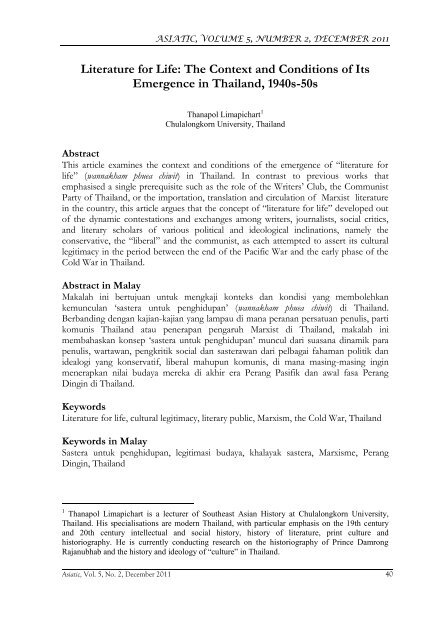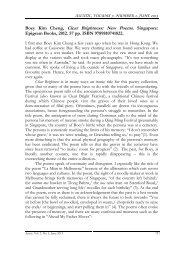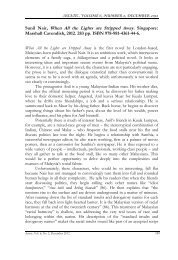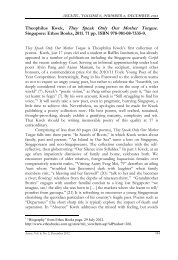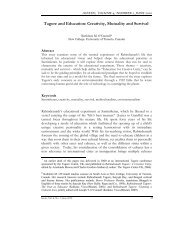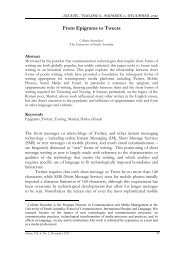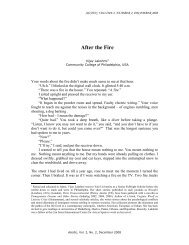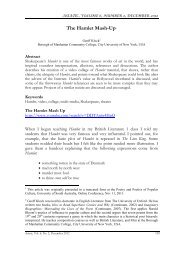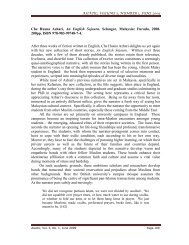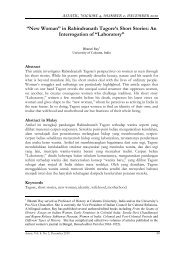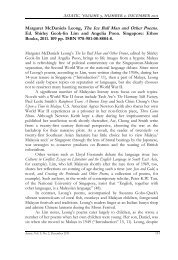Literature for Life: The Context and Conditions of Its ... - Asiatic
Literature for Life: The Context and Conditions of Its ... - Asiatic
Literature for Life: The Context and Conditions of Its ... - Asiatic
Create successful ePaper yourself
Turn your PDF publications into a flip-book with our unique Google optimized e-Paper software.
ASIATIC, VOLUME 5, NUMBER 2, DECEMBER 2011<br />
<strong>Literature</strong> <strong>for</strong> <strong>Life</strong>: <strong>The</strong> <strong>Context</strong> <strong>and</strong> <strong>Conditions</strong> <strong>of</strong> <strong>Its</strong><br />
Emergence in Thail<strong>and</strong>, 1940s-50s<br />
Thanapol Limapichart 1<br />
Chulalongkorn University, Thail<strong>and</strong><br />
Abstract<br />
This article examines the context <strong>and</strong> conditions <strong>of</strong> the emergence <strong>of</strong> “literature <strong>for</strong><br />
life” (wannakham phuea chiwit) in Thail<strong>and</strong>. In contrast to previous works that<br />
emphasised a single prerequisite such as the role <strong>of</strong> the Writers‟ Club, the Communist<br />
Party <strong>of</strong> Thail<strong>and</strong>, or the importation, translation <strong>and</strong> circulation <strong>of</strong> Marxist literature<br />
in the country, this article argues that the concept <strong>of</strong> “literature <strong>for</strong> life” developed out<br />
<strong>of</strong> the dynamic contestations <strong>and</strong> exchanges among writers, journalists, social critics,<br />
<strong>and</strong> literary scholars <strong>of</strong> various political <strong>and</strong> ideological inclinations, namely the<br />
conservative, the “liberal” <strong>and</strong> the communist, as each attempted to assert its cultural<br />
legitimacy in the period between the end <strong>of</strong> the Pacific War <strong>and</strong> the early phase <strong>of</strong> the<br />
Cold War in Thail<strong>and</strong>.<br />
Abstract in Malay<br />
Makalah ini bertujuan untuk mengkaji konteks dan kondisi yang membolehkan<br />
kemunculan „sastera untuk penghidupan‟ (wannakham phuea chiwit) di Thail<strong>and</strong>.<br />
Berb<strong>and</strong>ing dengan kajian-kajian yang lampau di mana peranan persatuan penulis, parti<br />
komunis Thail<strong>and</strong> atau penerapan pengaruh Marxist di Thail<strong>and</strong>, makalah ini<br />
membahaskan konsep „sastera untuk penghidupan‟ muncul dari suasana dinamik para<br />
penulis, wartawan, pengkritik social dan sasterawan dari pelbagai fahaman politik dan<br />
idealogi yang konservatif, liberal mahupun komunis, di mana masing-masing ingin<br />
menerapkan nilai budaya mereka di akhir era Perang Pasifik dan awal fasa Perang<br />
Dingin di Thail<strong>and</strong>.<br />
Keywords<br />
<strong>Literature</strong> <strong>for</strong> life, cultural legitimacy, literary public, Marxism, the Cold War, Thail<strong>and</strong><br />
Keywords in Malay<br />
Sastera untuk penghidupan, legitimasi budaya, khalayak sastera, Marxisme, Perang<br />
Dingin, Thail<strong>and</strong><br />
1 Thanapol Limapichart is a lecturer <strong>of</strong> Southeast Asian History at Chulalongkorn University,<br />
Thail<strong>and</strong>. His specialisations are modern Thail<strong>and</strong>, with particular emphasis on the 19th century<br />
<strong>and</strong> 20th century intellectual <strong>and</strong> social history, history <strong>of</strong> literature, print culture <strong>and</strong><br />
historiography. He is currently conducting research on the historiography <strong>of</strong> Prince Damrong<br />
Rajanubhab <strong>and</strong> the history <strong>and</strong> ideology <strong>of</strong> “culture” in Thail<strong>and</strong>.<br />
<strong>Asiatic</strong>, Vol. 5, No. 2, December 2011 40
<strong>Literature</strong> <strong>for</strong> <strong>Life</strong><br />
<strong>The</strong> years between the October 14 th, 1973 Uprising <strong>and</strong> the October 6 th, 1976<br />
Massacre were times <strong>of</strong> great political turmoil <strong>and</strong> ideological conflict in<br />
modern Thail<strong>and</strong>. <strong>The</strong>y witnessed not only the spread <strong>of</strong> political activism <strong>and</strong><br />
violence, but also the fierce battles <strong>for</strong> cultural hegemony among various<br />
groups, particularly between the radicals <strong>and</strong> the conservatives. According to<br />
Prajak Kongkirati, literature was one <strong>of</strong> the most contested sites <strong>of</strong> this cultural<br />
<strong>and</strong> ideological struggle as was manifested by the call <strong>for</strong> the “burning <strong>of</strong> Thai<br />
literary classics” (phao wannakhadi) by a group <strong>of</strong> radical students (452). 2 Thai<br />
literary classics were, according to them, legacies <strong>of</strong> the Thai feudal past <strong>for</strong> they<br />
served as the vehicle through which the ruling class indoctrinated the people<br />
with the idea that they were karmically destined to be superior. <strong>The</strong>se works<br />
were, moreover, viewed as pornographic <strong>and</strong> obscene since they were usually<br />
comprised <strong>of</strong> several love scenes. 3 Prajak argued that it was <strong>for</strong> these reasons<br />
that the radical students dismissed the literary classics <strong>and</strong> advocated instead the<br />
“literature <strong>for</strong> life” (wannakham phuea chiwit), which they defined as literature that<br />
served the interests <strong>of</strong> the common people <strong>and</strong> promoted social justice <strong>and</strong><br />
progress in the hope <strong>of</strong> changing the society <strong>for</strong> the better (449, 452).<br />
<strong>The</strong> literature <strong>for</strong> life that was promoted by the radical students in the<br />
1970s was neither a newly invented concept nor a newly translated term.<br />
Literary critics <strong>and</strong> Thai historians agree that it had already emerged <strong>and</strong><br />
become widely known in the 1950s. <strong>The</strong>se scholars disagree, however, as to<br />
how the concept developed <strong>and</strong> which groups should be credited with its<br />
popularisation. After the October 6 th, 1976 massacre, the young literary scholar,<br />
Trisilpa Boonkhachorn, <strong>and</strong> the critic, Sathian Chanthimathon, pointed out in<br />
their unrelated works that the emergence <strong>and</strong> dissemination <strong>of</strong> the notion <strong>of</strong><br />
literature <strong>for</strong> life owed much to a series <strong>of</strong> debates that took place at a literary<br />
organisation called <strong>The</strong> Writers‟ Club. 4<br />
Writing from a different perspective <strong>and</strong> in different contexts, two <strong>for</strong>mer<br />
radical students, Somsak Jeamteerasakul <strong>and</strong> Kasian Tejapira, proposed <strong>for</strong><br />
alternative interpretations <strong>of</strong> the emergence <strong>and</strong> dissemination <strong>of</strong> literature <strong>for</strong><br />
life. In his dissertation on the communist movement in Thail<strong>and</strong>, Somsak<br />
asserted that the Communist Party <strong>of</strong> Thail<strong>and</strong> (CPT) <strong>and</strong> its network were<br />
mainly responsible <strong>for</strong> introducing <strong>and</strong> popularising the concept <strong>of</strong> literature <strong>for</strong><br />
life. <strong>The</strong> political scientist Kasian agrees with Somsak on the influence <strong>of</strong> the<br />
communists but places his emphasis less on the CPT itself. In his book,<br />
Commodifying Marxism: <strong>The</strong> Formation <strong>of</strong> Modern Thai Radical Culture, 1927-1958,<br />
2 This call was however more <strong>of</strong> a provocative act <strong>of</strong> criticism than to actually burn the books.<br />
3 See Rai-ngan kan sammana rueang “khuan phao wannakhadi thai ruemai” (<strong>The</strong> Report from<br />
the Seminar on “Should We Burn Thai <strong>Literature</strong> [classics])”?<br />
4 See Trisilpa Boonkhachorn 145-46 <strong>and</strong> Sathian Chanthimathon 279.<br />
<strong>Asiatic</strong>, Vol. 5, No. 2, December 2011 41
Thanapol Limapichart<br />
Kasian argues that the process <strong>of</strong> importing, circulating <strong>and</strong> translating Marxist<br />
texts <strong>and</strong> ideas by different groups <strong>of</strong> various political inclinations were<br />
indispensable factors that eventually led to the rise <strong>of</strong> literature <strong>for</strong> life.<br />
This article does not dismiss the importance <strong>of</strong> the different factors <strong>and</strong><br />
preconditions that the above scholars claim to have led to the rise <strong>of</strong> literature<br />
<strong>for</strong> life. It argues, however, that this literary genre did not emerge out <strong>of</strong> a single<br />
prerequisite. It developed instead out <strong>of</strong> a series <strong>of</strong> dynamic contestations <strong>and</strong><br />
exchanges between various political <strong>and</strong> literary groups as each attempted to<br />
assert its cultural legitimacy in the period between the end <strong>of</strong> the Pacific War<br />
<strong>and</strong> the early phase <strong>of</strong> the Cold War in Thail<strong>and</strong>.<br />
<strong>The</strong> Postwar Thai Literary Public Sphere<br />
<strong>The</strong> period between the 1932 Revolution <strong>and</strong> the Pacific War saw great<br />
expansion <strong>of</strong> print capitalism in Thail<strong>and</strong>. According to Chusri, the production<br />
<strong>of</strong> cheap <strong>and</strong> popular paperback fiction, locally known as the 10-satang-fiction,<br />
became an industry (93). Famous publishing houses that concentrated on<br />
popular fiction, such as Phloenchit, Hem Wetchakon, Uthen <strong>and</strong> Udom, also<br />
came into being <strong>and</strong> grew into maturity, as is evidenced by their large print runs.<br />
With only a few exceptions, the first printing <strong>of</strong> a paperback work <strong>of</strong> fiction in<br />
the 1920s was generally around 1,000 copies (Sathian Chanthimathon 127). In<br />
the 1930s, however, the publishing houses were printing not only a few<br />
thous<strong>and</strong> copies but eight, nine or even thirty thous<strong>and</strong> copies <strong>of</strong> paperback<br />
works <strong>of</strong> fiction, depending on the popularity <strong>of</strong> the writer (Sathian<br />
Chanthimathon 127).<br />
This trend <strong>of</strong> expansion slowed down during the war. A number <strong>of</strong><br />
political <strong>and</strong> socioeconomic factors contributed to it, but two important sets <strong>of</strong><br />
factors are worth mentioning. First, the Phibun government‟s language <strong>and</strong><br />
moral policies aimed not only to promote Thai cultural nationalism, but also to<br />
establish government control over public language usage <strong>and</strong> literary<br />
production. <strong>The</strong>se policies included an imposition <strong>of</strong> a new spelling system <strong>and</strong>,<br />
even more controversially, the censorship <strong>of</strong> the content <strong>of</strong> fiction. According<br />
to Trisilpa Boonkhachorn, at the introduction <strong>of</strong> these measures, many<br />
prominent writers such as Malai Chuphinit <strong>and</strong> Chot Phraephan stopped<br />
writing in protest (89).<br />
<strong>The</strong> shortages <strong>and</strong> the price increase <strong>of</strong> paper, along with the<br />
government‟s regulation <strong>of</strong> its distribution, also contributed to the decline in<br />
literary production in this period. As Chot Phraephan pointed out in early 1945,<br />
the Phibun government regulated the distribution <strong>of</strong> paper by controlling access<br />
to paper factories. He highlighted that the government only allowed certain<br />
newspapers to purchase paper from the factories at a negotiated price, but left<br />
publishing houses to buy it on the black market, where the prices were twenty<br />
<strong>Asiatic</strong>, Vol. 5, No. 2, December 2011 42
<strong>Literature</strong> <strong>for</strong> <strong>Life</strong><br />
times higher than they were at the factories (Yakhob 1-42). Publishing fiction<br />
thus became increasingly more difficult in the final years <strong>of</strong> the war.<br />
<strong>The</strong> Thai literary market was, however, rejuvenated as the war came to a<br />
close, <strong>and</strong> by the late 1940s, it had entered a new phase <strong>of</strong> expansion. Not only<br />
did the old publishing houses recover <strong>and</strong> become prosperous once again, but<br />
new houses also started to mushroom. 5 Hundreds <strong>of</strong> new literary works were<br />
published along with a number <strong>of</strong> old works by well-known writers from the<br />
late 1920s to the beginning <strong>of</strong> the war, including works by Kulap Saipradit,<br />
M.C. Akatdamkoeng Raphiphat <strong>and</strong> <strong>Its</strong>ara Amantakun. No less important a<br />
phenomenon in this period was the boom experienced by weekly <strong>and</strong> monthly<br />
literary magazines <strong>and</strong> special issues <strong>of</strong> newspapers (the Sunday or Monday<br />
issue <strong>of</strong> many newspapers devoted most <strong>of</strong> its space especially to short stories<br />
or serialised novels each week). <strong>The</strong>se magazines <strong>and</strong> newspapers, Bo Daeng,<br />
Phloenchit rai sapda, Sayam samai rai sapda, Roengrom rai sapda, Deli mel wanchan <strong>and</strong><br />
Piyamit wan-athit, to name only a few, were significant outlets <strong>for</strong> writers <strong>and</strong><br />
crucial suppliers <strong>of</strong> new material to the continuously exp<strong>and</strong>ing reading public.<br />
In fact, nearly all <strong>of</strong> the famous Thai novels from this period were first<br />
serialised in these weekly <strong>and</strong> monthly magazines <strong>and</strong> newspapers.<br />
In addition to the dramatic increase in the publication <strong>of</strong> literary works,<br />
the postwar literary public sphere also witnessed the birth <strong>of</strong> new literary genres.<br />
An example <strong>of</strong> these new genres was “the crime <strong>and</strong> violence romance,” which<br />
was, as the historian Chalong Soontravanich argues, a byproduct <strong>of</strong> the<br />
proliferation <strong>of</strong> modern small arms <strong>and</strong> the spread <strong>of</strong> crime <strong>and</strong> violence during<br />
<strong>and</strong> after the war (26-46). Another <strong>and</strong> more controversial example <strong>of</strong> the new<br />
literary genres that emerged after the war was pornography. <strong>The</strong>re previously<br />
existed various literary genres that contained erotic <strong>and</strong> sexual representation,<br />
including bot atsachan (erotic or sexual portrayal) <strong>of</strong> Thai classical literature, 6<br />
risqué <strong>and</strong> humorous poetic tales, traditional <strong>and</strong> modern or scientific manuals<br />
<strong>for</strong> carnal knowledge <strong>and</strong> sexual education, <strong>and</strong> the so-called “indecent books”<br />
(nangsu po) <strong>of</strong> the 1920s <strong>and</strong> 1930s. However, the war <strong>and</strong> its aftermath saw the<br />
emergence <strong>of</strong> more sexually explicit genres such as erotic fiction <strong>and</strong> hardcore<br />
pornography. 7<br />
5 Interview with Sombat Phlainoi, September 29, 2004. Also see, <strong>for</strong> instance, Yot<br />
Watcharasathian 211 <strong>and</strong> Chusri Kalawantavanit 105-107.<br />
6 Sexual or erotic portrayal is a significant part <strong>of</strong> Thai classical dramatic epics <strong>and</strong> romance<br />
poems. See, <strong>for</strong> instance, Phra lo, Phra aphra aphaimani, Khun chang khun phaen, <strong>and</strong> various<br />
works <strong>of</strong> Nirat.<br />
7 <strong>The</strong> story <strong>of</strong> the widespread publication <strong>of</strong> pornography (nangsu po) in the postwar period is<br />
legendary. Interview with Sombat Phlainoi, September 29, 2004. Also see, Nangsu an len phit<br />
sinlatham (Immoral Books), file NA. (3) SR. [Office <strong>of</strong> the Chief Secretary to the Cabinet]<br />
<strong>Asiatic</strong>, Vol. 5, No. 2, December 2011 43
Thanapol Limapichart<br />
Another significant development in the Thai literary sphere after the war<br />
was the establishment <strong>of</strong> various politico-literary groups, which was the result<br />
<strong>of</strong> the trans<strong>for</strong>mation <strong>of</strong> the Thai political <strong>and</strong> ideological l<strong>and</strong>scapes. <strong>The</strong><br />
defeat <strong>of</strong> the Axis <strong>and</strong> the Japanese by the Allies brought about the fall <strong>of</strong> the<br />
authoritarian government <strong>of</strong> Phibun, which allied itself with the Japanese. This<br />
demise <strong>of</strong> the ruling government led, in turn, to the re-emergence <strong>of</strong> various<br />
political groups that had previously been suppressed or silenced. One <strong>of</strong> these<br />
groups was Pridi Banomyong 8 <strong>and</strong> his many supporters. Pridi was the leader <strong>of</strong><br />
the Free Thai movement (Khabuankan Seri Thai) <strong>and</strong> represented the liberal/<br />
leftist political stance. Upon his return to power, Pridi also brought back the<br />
royalists by granting amnesty to those who were jailed or <strong>for</strong>ced into exile<br />
during the Phibun regime as well as by restoring King Prajakhipok‟s honours<br />
posthumously (Baker, Chris <strong>and</strong> Pasuk Phongpaichit 141-42). In addition to the<br />
liberal/ leftist fraction <strong>of</strong> Pridi <strong>and</strong> the conservative royalists, the Communist<br />
Party <strong>of</strong> Thail<strong>and</strong> also enjoyed postwar political trans<strong>for</strong>mation. As Kasian<br />
points out, after the war the communists “emerged triumphantly from prison<br />
<strong>and</strong> from the underground.” With the support <strong>of</strong> Pridi <strong>and</strong> his clique, the Anti-<br />
Communist Act implemented in the mid-1930s was abrogated in 1946, <strong>and</strong><br />
communism was legalised. <strong>The</strong> Communist Party <strong>of</strong> Thail<strong>and</strong> <strong>and</strong> its associates<br />
could then begin publicly organising their political, social <strong>and</strong> intellectual<br />
activities (Kasian Tejapira 56-57).<br />
<strong>The</strong>se political changes stimulated literary activities among the different<br />
political <strong>and</strong> ideological groups. A group <strong>of</strong> conservative scholars led by M.R.<br />
Sumonchat Sawatdikul <strong>and</strong> M.L. Chitti Noppavong did, <strong>for</strong> instance, found a<br />
literary club called Wong wannakhadi (Literary Circle) in early 1946. <strong>The</strong> club<br />
published a monthly journal under the same name <strong>and</strong> organised an annual<br />
meeting <strong>for</strong> literary discussions (Chonlada Ruangraklikit, Runruthai Satchaphan<br />
<strong>and</strong> Duangmon Chitchamnong 169-70). In addition to regular republications <strong>of</strong><br />
the works <strong>of</strong> King Chulalongkorn, King Vajiravudh <strong>and</strong> other royal elites,<br />
including Prince Damrong Rajanubhab <strong>and</strong> Prince Bhidayalongkorn, the journal<br />
also published works <strong>of</strong> prominent literati such as Phraya Anumanratchathon,<br />
Worawet Siwasariyanon, Wit Siwasariyanon, P.S. Sattri, Thanit Yupho, Chuea<br />
Satawethin <strong>and</strong> Samak Burawat. <strong>The</strong> majority <strong>of</strong> the articles published in Wong<br />
Wannakhadi focused on the subjects <strong>of</strong> Thai classical literature, literary art <strong>and</strong><br />
0201.55/52, National Archives <strong>of</strong> Thail<strong>and</strong>. Not only were pornographic books widespread, so<br />
were pornographic movies (nang po). See Noi Inthanon (Malai Chuphinit) 4.<br />
8 Pridi was a founding member <strong>of</strong> the People’s Party that overthrew the absolute monarchy in the<br />
1932 Revolution. He served as the finance minister in the Phibun government be<strong>for</strong>e he left the<br />
post to become regent in 1941 because <strong>of</strong> his conflict with Phibun over the latter’s decision to ally<br />
with the Japanese. During his time as regent, Pridi gradually developed a better relationship with<br />
some members <strong>of</strong> the royal family with whom he later <strong>for</strong>med an alliance against the Phibun<br />
government.<br />
<strong>Asiatic</strong>, Vol. 5, No. 2, December 2011 44
<strong>Literature</strong> <strong>for</strong> <strong>Life</strong><br />
history, unlike other journals <strong>of</strong> its kind which laid their emphases more on the<br />
publication <strong>of</strong> short stories or serialised novels. 9<br />
<strong>The</strong> Wong Wannakhadi journal was endorsed by King An<strong>and</strong>a [r. 1935-46],<br />
who claimed to read <strong>and</strong> enjoy it. Thus, in his comment on the first anniversary<br />
<strong>of</strong> the journal, Prince Dhani Nivas praised Wong Wannakhadi not only <strong>for</strong> its<br />
intellectual value as a treasure <strong>of</strong> literary knowledge but more significantly <strong>for</strong> its<br />
express loyalty to the monarch (2-4). Later, the journal also published regular<br />
reports on the activities <strong>and</strong> well-being <strong>of</strong> King Bhumibol [r. 1946-], King<br />
An<strong>and</strong>a‟s brother <strong>and</strong> successor. In a sense, the founding <strong>of</strong> the Literary Circle<br />
can arguably be interpreted as the royal elite‟s attempt to reassert the link<br />
between the monarchy <strong>and</strong> literature (wannakhadi), specifically the monarch‟s<br />
patronage <strong>of</strong> Thai literature, an idea that had diminished since the 1932<br />
Revolution.<br />
On the opposite ideological <strong>and</strong> political pole, the communists <strong>and</strong> leftists<br />
in general arose as producers <strong>and</strong> providers <strong>of</strong> new literary work, knowledge<br />
<strong>and</strong> criticism. 10 Soon after the fall <strong>of</strong> the Phibun government, the CPT-affiliated<br />
newspaper Mahachon (<strong>The</strong> Masses) “emerged from cl<strong>and</strong>estineness as a legal<br />
commercial weekly publication with a newly exp<strong>and</strong>ed, competent <strong>and</strong> versatile<br />
editorial staff” (Kasian Tejapira 152). <strong>Its</strong> new staff included the Marxist <strong>and</strong><br />
Maoist literary critic Udom Sisuwan <strong>and</strong> the radical poet <strong>and</strong> critic Atsani<br />
Phonlachan. <strong>The</strong> newspaper regularly published short stories by “progressive”<br />
writers such as Sot Kuramarohit, <strong>Its</strong>ara Amantakun, Thida Bunnag <strong>and</strong> Po<br />
Buransinlapin (Puan Buranapakon) (Kasian Tejapira 152).<br />
Another example <strong>of</strong> this postwar literary activity among the leftist/<br />
progressive groups was the publication <strong>of</strong> the monthly magazine Aksonsan<br />
(Inscribed Advice) in 1949. Founded <strong>and</strong> published by Supha Sirimanon, a<br />
leftist/ progressive <strong>and</strong> pro-Pridi journalist, <strong>and</strong> his wife Chinda, the magazine<br />
had a short publishing life but made major contributions to the literary public<br />
discourse by serving as an intellectual plat<strong>for</strong>m <strong>for</strong> political <strong>and</strong> literary debates<br />
as well as a source <strong>of</strong> new literary ideas <strong>and</strong> theories, including Marxist, Leninist<br />
<strong>and</strong> Maoist literary doctrines. However, unlike Mahachon which was committed<br />
to Marxist ideology, Aksonsan initially aimed at representing various ideologies,<br />
ranging from the conservative to the liberal to the socialist <strong>and</strong> finally to the<br />
communist point <strong>of</strong> view. As Kasian notes, however, its position would<br />
gradually turn “left” <strong>and</strong> become more radical as time went by until it was<br />
finally attenuated by the press censorship in the aftermath <strong>of</strong> the military coup<br />
in late 1951 (164-70).<br />
9 However, it published a number <strong>of</strong> short stories by internationally celebrated writers, such as<br />
Rabindranath Tagore <strong>and</strong> W. Somerset Maugham.<br />
10 For a history <strong>of</strong> early influence <strong>of</strong> Marxist <strong>and</strong> socialist thoughts in Thai literary public sphere,<br />
see Smith Thanomsasana 48-52.<br />
<strong>Asiatic</strong>, Vol. 5, No. 2, December 2011 45
Thanapol Limapichart<br />
<strong>The</strong>se newspapers <strong>and</strong> literary journals not only represented the different<br />
political fractions that emerged after the war, but also generated discussions<br />
about literature <strong>and</strong> criticism that captures the ideological contestation among<br />
them. <strong>The</strong>se discussions focused on such issues as the proper role <strong>of</strong> writers,<br />
the social function <strong>of</strong> art <strong>and</strong> literature, the place <strong>of</strong> literature in politics, <strong>and</strong><br />
vice versa, as well as the distinction between art <strong>and</strong> obscenity.<br />
<strong>The</strong> Marxist Introduction <strong>of</strong> a New Concept <strong>of</strong> <strong>Literature</strong><br />
In January 1947, Udom 11 published a critical review <strong>of</strong> Po Buransasinlapin<br />
(hereafter Puan)‟s recent book Chiwit chak mum mut (Lives from the Dark<br />
Corner) in Mahachon. It was not simply a regular book review but was an<br />
attempt to introduce a new concept <strong>of</strong> literature <strong>and</strong> literary writing to the Thai<br />
public. In it Udom, writing under the pen name O Sisuwan, criticised the idea<br />
<strong>of</strong> art <strong>for</strong> art‟s sake. 12 He argued that “art was not what was in the mind <strong>of</strong> a<br />
writer but what belonged to the people.” Udom believed that art was, like other<br />
social entities, inevitably involved in politics <strong>and</strong> always a part <strong>of</strong> its struggle.<br />
Whether or not a writer was conscious <strong>of</strong> this, he had responsibilities toward his<br />
readers <strong>and</strong> thus should always remind himself “<strong>for</strong> whom he writes <strong>and</strong> how<br />
he should write it” (O Sisuwan 6, 8-9).<br />
Influenced by Romain Roll<strong>and</strong>, a famous French writer <strong>and</strong> pacifist,<br />
Udom believed that writers had the obligation <strong>of</strong> shaping tolerant, motivated<br />
<strong>and</strong> courageous readers “who strove toward knowledge, beauty, love <strong>of</strong><br />
humanity <strong>and</strong> public progress” (O Sisuwan 6). He consequently hailed Puan‟s<br />
book as a truly ground breaking work that not only attempted to portray the<br />
lives <strong>of</strong> the poor <strong>and</strong> the outcasts, but also showed the dignity <strong>and</strong> humanity <strong>of</strong><br />
its poverty-stricken characters. To affirm the value <strong>of</strong> Puan‟s book, Udom<br />
ended his review with the note that “an art that only entertained the well-to-do<br />
was less valuable than the one that spoke <strong>for</strong> the poor” (O Sisuwan 8, 10).<br />
11 Udom was an ethnic Chinese <strong>and</strong> a member <strong>of</strong> both the Chinese Communist Party <strong>and</strong> CPT. As<br />
a young man, he went to China in the late 1930s <strong>and</strong> spent time there fighting the Japanese <strong>and</strong><br />
studying in the communist party’s school, where he learned, in his own words, “economics, about<br />
surplus value <strong>and</strong> commodities <strong>and</strong> New Democracy, Yenan literature, self-cultivation <strong>and</strong> the<br />
Communist Manifesto” (Somsak Jeamteerasakul 14-15, 208-09). He was asked to return to<br />
Thail<strong>and</strong> in 1945, <strong>and</strong> became a staff member <strong>of</strong> Mahachon.<br />
12 <strong>The</strong> idea <strong>of</strong> art <strong>for</strong> art’s sake had frequently been mentioned along with the concepts <strong>of</strong> “literary<br />
art” (wannasin) <strong>and</strong> <strong>of</strong> “the writer as an artist” (sinlapin) by a number <strong>of</strong> writers <strong>and</strong> literary<br />
scholars, both conservative <strong>and</strong> “liberal,” during the Pacific War. After the war, it was further<br />
discussed <strong>and</strong> popularised by the conservative journals such as the Wong Wannakhadi <strong>and</strong><br />
Sinlapakorn <strong>and</strong> the group called “Chakkrawat Sinlapin” (<strong>The</strong> Empire <strong>of</strong> the Artist). However, it<br />
should be noted that even among the conservative scholars, there were some who tried to argue<br />
against the extreme interpretation <strong>of</strong> the idea that art should only exist <strong>for</strong> its own sake. See<br />
Thanapol Limapichart 61-72.<br />
<strong>Asiatic</strong>, Vol. 5, No. 2, December 2011 46
<strong>Literature</strong> <strong>for</strong> <strong>Life</strong><br />
A few months after the publication <strong>of</strong> Udom‟s book review, Mahachon<br />
announced its contest <strong>for</strong> a short story <strong>of</strong> the week. Writers whose stories won<br />
the contest would receive an award <strong>of</strong> 40 baht, <strong>and</strong> the story would be<br />
published in the newspaper. In the announcement, the newspaper‟s staff<br />
<strong>of</strong>fered the following guidelines <strong>for</strong> the kind <strong>of</strong> story they would look <strong>for</strong>:<br />
In our opinion, a story should not be only about the art <strong>of</strong> creating<br />
affection, sentiment, happiness <strong>and</strong> sadness through the use <strong>of</strong> language.<br />
<strong>The</strong> value <strong>of</strong> writing should be more than that. That is, it should guide the<br />
society, expose the [society‟s] wickedness <strong>and</strong> shape the mind [<strong>of</strong> the<br />
readers]. It should benefit the majority <strong>of</strong> the people who live in hardship<br />
<strong>and</strong> oppression. For us, this is the true meaning <strong>and</strong> value <strong>of</strong> writing.<br />
(“Katika prakuat „rueang ek pracham sapda‟” 6)<br />
Arguably, the announcement <strong>and</strong> the contest indicated the attempt <strong>of</strong> the<br />
newspaper <strong>and</strong> perhaps the CPT itself to promote the new concept <strong>of</strong> literature<br />
that was also outlined by Udom in his book review.<br />
In 1947 <strong>and</strong> 1948, Mahachon published at least two short stories weekly.<br />
Nearly all <strong>of</strong> the stories followed the guidelines above. For instance, most <strong>of</strong><br />
their heroes or heroines were servants, workers, prostitutes <strong>and</strong> peasants who<br />
suffered or were taken advantage <strong>of</strong> by greedy factory owners, heartless<br />
l<strong>and</strong>lords <strong>and</strong> corrupt <strong>of</strong>ficials. Most <strong>of</strong> the stories published in the newspaper<br />
during this time were not from the contest entrants but from the party<br />
associates <strong>and</strong> amateur writers such as Sombat Phlainoi (more commonly<br />
known as So Phlainoi), who was not at all radical or interested in Marxism<br />
(Somsak Jeamteerasakul 297). 13 As the historian Somsak argues, the party also<br />
tried to encourage some already well-known writers to produce works <strong>of</strong> this<br />
kind. His observation is confirmed by the fact that some writers, <strong>for</strong> example,<br />
Ko Surangkhanang (Kanha Khiangsiri), then wife <strong>of</strong> Puan, Somchai<br />
Atsanachinda, Thida Bunnag, <strong>Its</strong>ara Amantakun <strong>and</strong> Nongyao Praphasathit,<br />
published their stories in Mahachon. One should note, however, that although<br />
most <strong>of</strong> their works were about the poor <strong>and</strong> their sufferings, they were not<br />
necessarily ideologically oriented.<br />
As the radical Mahachon tried to establish a new type <strong>of</strong> literary work <strong>and</strong><br />
criticism, the progressive journals also began to open up questions about the<br />
meaning <strong>and</strong> value <strong>of</strong> literature. An editorial essay in the new weekly literary<br />
journal Suphapburut chabap krapao (<strong>The</strong> Gentleman: A Pocketbook Version)<br />
promoted, <strong>for</strong> example, a new concept <strong>and</strong> function <strong>of</strong> literature which its<br />
13 Sombat Phlainoi would later become a famous feature writer.<br />
<strong>Asiatic</strong>, Vol. 5, No. 2, December 2011 47
Thanapol Limapichart<br />
author called, in English, a “story <strong>of</strong> a purpose.” 14 Using the works <strong>of</strong><br />
Nongyao 15 as an example, the author declared that a writer <strong>of</strong> stories with a<br />
purpose was someone who intended to make his readers think, either through<br />
his criticism <strong>of</strong> the society or his portrayal <strong>of</strong> people who were suffering. In<br />
other words, the work aimed not at entertaining any person in particular but at<br />
benefiting humanity as a whole (“Chintanakan khong nakpraphan” 77-78).<br />
In his introduction to Kulap‟s short story in Aksonsan, the editor, Supha,<br />
expressed similar views about the function <strong>of</strong> literature <strong>and</strong> described Kulap‟s<br />
writings especially Songkhram chiwit (<strong>The</strong> War <strong>of</strong> <strong>Life</strong>) as works with “the<br />
purpose… <strong>of</strong> revolutionising thought <strong>and</strong> re<strong>for</strong>ming society” (276-78). In<br />
another introductory essay published a few months later, Supha further<br />
developed this new concept <strong>of</strong> literature <strong>and</strong> coined the term nawaniyai thi mi<br />
khwam mungmai (novels with a purpose). <strong>The</strong> term, as he defined it, referred to a<br />
group <strong>of</strong> works that possessed the power to trans<strong>for</strong>m the readers‟ mind <strong>and</strong><br />
inspire them to cast <strong>of</strong>f the oppressive <strong>for</strong>ces <strong>of</strong> tradition (282-84).<br />
Supha pointed out that this new literary genre had, historically speaking,<br />
flourished in the West in the past hundred years. His examples ranged from<br />
classics such as most <strong>of</strong> Charles Dickens‟s novels, Victor Hugo‟s Les Miserables,<br />
Voltaire‟s C<strong>and</strong>ide <strong>and</strong> Harriet Beecher Stowe‟s Uncle Tom’s Cabin, to the<br />
contemporary works <strong>of</strong> American progressive writers such as Sinclair Lewis,<br />
Upton Sinclair <strong>and</strong> Howard Fast. In the Thai case, he mentioned the works <strong>of</strong><br />
<strong>Its</strong>ara, especially those written after the war. According to Supha, <strong>Its</strong>ara‟s<br />
postwar works indicated a shift in his direction as a writer. As he gained more<br />
experience <strong>of</strong> the world <strong>and</strong> as a writer, he came to acknowledge the existence<br />
<strong>of</strong> social injustice, inequality between the haves <strong>and</strong> have-nots, <strong>and</strong> “the<br />
bloodsucking behaviours <strong>of</strong> the demigods” (sommutdithep). Supha concluded the<br />
essay on the hopeful <strong>and</strong> confident note that the dissemination <strong>of</strong> these works<br />
would be able to overthrow any oppressive power (282-84).<br />
<strong>The</strong> influence that Marxist <strong>and</strong> progressive thinkers <strong>and</strong> their new<br />
concept <strong>of</strong> literature in this period had on the emergence <strong>of</strong> the concept <strong>of</strong><br />
“literature <strong>for</strong> life” has long been noted by historians such as Somsak. As<br />
unmistakable as this influence might have been, however, it was hardly the only<br />
factor that contributed to the rise <strong>of</strong> this new literary genre. <strong>Literature</strong> <strong>for</strong> life<br />
was arguably also shaped by the debates that took place at Chomrom Nakpraphan<br />
or the Writers‟ Club. It was, as will be shown in the next section, during these<br />
debates that Marxist <strong>and</strong> progressive thinkers <strong>and</strong> their ideas came into<br />
14 Although the article did not contain the author’s name, it is possible that the piece was written<br />
by Puan Buranapakon.<br />
15 Nongyao Praphasathit belonged to the early generation <strong>of</strong> female writers. She worked with<br />
Kulap Saipradit at Prachachat newspaper in 1937, <strong>and</strong> later at Prachamit-Suphapburut newspaper<br />
during the war.<br />
<strong>Asiatic</strong>, Vol. 5, No. 2, December 2011 48
<strong>Literature</strong> <strong>for</strong> <strong>Life</strong><br />
contestation with their more conservative counterpart, which in turn helped<br />
refine their new concept <strong>of</strong> literature that would later become known as<br />
“literature <strong>for</strong> life.”<br />
<strong>The</strong> Intellectual Debates at the Writers’ Club<br />
<strong>The</strong> Writers‟ Club was established <strong>and</strong> organised by three well-known writers<br />
<strong>and</strong> journalists: Malai, Wilat Maniwat <strong>and</strong> Prayat So Nakhanat, who also served<br />
as the Club‟s president. It was financially supported by Ari Liwira, the owner <strong>of</strong><br />
Thai Phanitchayakan, one <strong>of</strong> the biggest <strong>and</strong> most influential publishing houses<br />
after the war. <strong>The</strong> original purpose <strong>of</strong> the club was, according to Wilat, to allow<br />
writers to meet, discuss <strong>and</strong> exchange ideas so as to contribute to the general<br />
progress <strong>of</strong> the art <strong>of</strong> writing. In this sense, its claim was not much different<br />
from previous literary organisations that had been established by the<br />
government or the ruling elite. 16 Wilat implied, however, that the inspiration <strong>for</strong><br />
the club actually derived from various international sources <strong>and</strong> examples,<br />
including Flaubert‟s opening his house in Paris <strong>for</strong> his writer friends, the<br />
gatherings <strong>of</strong> American writers such as Emerson <strong>and</strong> Thoreau in Concord,<br />
Massachusetts, the activities <strong>of</strong> the Bloomsbury Group in Engl<strong>and</strong>, <strong>and</strong> the<br />
regular meetings among Thai poets <strong>and</strong> writers at Prince Bhidayalongkorn‟s<br />
house in the 1930s (Wilat 80-83).<br />
<strong>The</strong> Writers‟ Club organised over twenty meetings between 1950 <strong>and</strong><br />
1951 to discuss various topics concerning literature. <strong>The</strong> meetings were<br />
attended by well-established writers, literary critics <strong>and</strong> literary scholars <strong>of</strong> both<br />
genders <strong>and</strong> from all political <strong>and</strong> ideological backgrounds. <strong>The</strong> details <strong>of</strong> each<br />
meeting were afterwards reported by Wilat, writing under the pen name Olan,<br />
in the Thai Phanitchayakan weekly <strong>and</strong> monthly newspapers, first in Roengrom rai<br />
sapda, then in Phim thai (wanchan) – Roengrom rai sapda, <strong>and</strong> later on, in Phim thai<br />
rai duean. <strong>The</strong> publication <strong>of</strong> the reports in such widely-distributed newspapers<br />
meant that the debates could be followed by the general public as well as writers<br />
who did not themselves attend the meetings. It followed, there<strong>for</strong>e, that the<br />
issues that were debated among the members <strong>of</strong> the Writers‟ Club had an<br />
impact that reached beyond the club‟s circle. During its first meeting, which<br />
took place at the Thai Phanitchayakan <strong>of</strong>fice in late January 1950, the club<br />
decided to discuss “the duty <strong>and</strong> responsibility <strong>of</strong> writers,” an issue that was<br />
critically important to the participants <strong>and</strong> would be taken up again in later<br />
debates.<br />
Those who participated in the debate on this particular issue could be<br />
roughly divided into two groups. <strong>The</strong> first saw literature as an art <strong>for</strong>m <strong>and</strong><br />
thought <strong>of</strong> themselves <strong>and</strong> other writers as artists whose sole responsibility was<br />
to the art itself. When commenting on the role <strong>of</strong> writers, <strong>for</strong> example, Malai<br />
16 See Thanapol Limapichart.<br />
<strong>Asiatic</strong>, Vol. 5, No. 2, December 2011 49
Thanapol Limapichart<br />
elaborated on his own personal approach to writing by saying “when I have a<br />
story to tell, I will write about it, <strong>and</strong> think <strong>of</strong> nothing else. I am honest only to<br />
myself <strong>and</strong> responsible to my characters…. As <strong>for</strong> the people, I am not<br />
concerned about them. I do not worry about whether or not they will like my<br />
work. I write to satisfy myself alone” (Olan, Phim thai (wanchan) – roengrom rai<br />
sapda 3.137: 21-24, 28).<br />
Another participant in the debate who held a similar position with regards<br />
to the responsibility <strong>of</strong> writers was Wit, a young, European-educated literary<br />
critic <strong>and</strong> scholar. Wit observed, in his address to the club, that Thai people<br />
tended to place too much emphasis on moral lessons (khati), which were, <strong>for</strong><br />
him, not the objective <strong>of</strong> art. Writers, he suggested, should remind themselves<br />
that their duty was not to preach to all <strong>of</strong> humanity (prot sat) but to create a<br />
work <strong>of</strong> art (Olan, Phim thai (wanchan) – roengrom rai sapda 3.137: 23). Wit did not,<br />
however, push his position to the extreme. He claimed instead that the idea <strong>of</strong><br />
art <strong>for</strong> art‟s sake <strong>and</strong> <strong>for</strong> nothing else was untenable although he never<br />
elaborated on how to create a work <strong>of</strong> art that did not exist solely <strong>for</strong> its own<br />
sake (Olan, Phim thai rai duean 3.26: 34).<br />
Interacting against these ideas were those espoused by the Marxist <strong>and</strong><br />
leftist thinkers who were, as we have seen in the previous section, starting to<br />
<strong>for</strong>mulate ideas about a new genre <strong>of</strong> literature. Atsani claimed, <strong>for</strong> instance,<br />
that writers should not write simply to satisfy themselves but should try to serve<br />
the cause <strong>of</strong> the people especially the poor <strong>and</strong> the disadvantaged. He declared,<br />
<strong>for</strong> example, that he <strong>and</strong> other writers “are with the people; [they] are part <strong>of</strong><br />
the people” (Olan, Phim thai (wanchan) – roengrom rai sapda 3. 137: 23). Though<br />
himself a conservative scholar, Pluang Na Nakhon agreed with Atsani that<br />
writers had responsibilities not only to themselves but to others as well. He did<br />
not think, however, that writers had an obligation to promote the people‟s<br />
interests. He believed instead in the didactic function <strong>of</strong> literature <strong>and</strong> argued<br />
that writers should answer the call from both the state <strong>and</strong> the society to use<br />
their works in order to uphold the st<strong>and</strong>ard <strong>of</strong> morality (Olan, Phim thai<br />
(wanchan) – roengrom rai sapda 3.137: 23).<br />
<strong>The</strong> discussion <strong>of</strong> the role <strong>and</strong> responsibility <strong>of</strong> writers was taken up again<br />
when the club took on the issue <strong>of</strong> the political novel. <strong>The</strong> debates were intense<br />
because the participants not only held different views on the function <strong>of</strong> art <strong>and</strong><br />
literature but also realised, <strong>for</strong> the most part, that writing a novel could be<br />
political. Sa-ngop Suansiri humorously remarked: “except <strong>for</strong> the homework a<br />
teacher assigns, everything else is political” (Olan, Phim thai (wanchan) – roengrom<br />
rai sapda 3.137: 28). Speaking from the “art <strong>for</strong> art‟s sake” position, M.R. Kukrit<br />
Pramoj, a royalist politician <strong>and</strong> writer, argued that writing a novel was not<br />
about shaping people to be good or evil. It was rather a vehicle <strong>for</strong> a writer‟s<br />
artistic <strong>and</strong> emotional expression. If anyone wanted to write in order to<br />
<strong>Asiatic</strong>, Vol. 5, No. 2, December 2011 50
<strong>Literature</strong> <strong>for</strong> <strong>Life</strong><br />
admonish the people, Kukrit believed he should become a preacher rather than<br />
a writer (Olan, Phim thai (wanchan) – roengrom rai sapda 3.137: 28).<br />
Agreeing with Kukrit, Banchop Chuwanon, a journalist <strong>and</strong> newspaper<br />
editor, expressed his opinion during the debate on the meaning <strong>of</strong> “art <strong>for</strong> art‟s<br />
sake” that “artists, either writers or painters, do not, in fact, think <strong>of</strong> the people.<br />
What they are concerned with is how they can translate their imagination into<br />
their works. Whatever the critics think is not important” (Olan, Phim thai<br />
(wanchan) – roengrom rai sapda 4.141: 21-23). He further criticised the idea <strong>of</strong> “art<br />
<strong>for</strong> people” as being beyond the realm <strong>of</strong> art itself as it had a tendency to be<br />
involved in politics. He said everything seemed, at that moment, to be all about<br />
nationalism <strong>and</strong> politics, <strong>and</strong> it would be a loss if art too was exploited <strong>for</strong><br />
nationalistic <strong>and</strong> political ends.<br />
In contrast to Kukrit‟s <strong>and</strong> Banchop‟s autotelic view, Kulap believed that<br />
literature has the function <strong>of</strong> serving the people‟s interests. 17 He explained that,<br />
in the past, artists had no artistic freedom because they worked under the<br />
patronage system <strong>of</strong> the traditional elite. After the market system has replaced<br />
the earlier patronage one, however, artists were still not completely free because<br />
they had to follow the dem<strong>and</strong>s <strong>of</strong> the market. <strong>The</strong> question <strong>for</strong> Kulap was<br />
how, under these new circumstances, writers could <strong>of</strong>fer the greatest benefits to<br />
the greatest number <strong>of</strong> people, that is, how writers could make the poor <strong>and</strong> the<br />
disadvantaged realise the inferiority <strong>of</strong> their situation <strong>and</strong> want to change their<br />
lives <strong>for</strong> the better (Olan, Phim thai (wanchan) – roengrom rai sapda 3.137: 28).<br />
Although those who attended the Writers Club‟s meetings seemed to be<br />
divided into two camps on the issue <strong>of</strong> the role <strong>and</strong> responsibility <strong>of</strong> writers, it<br />
is important to note that some also tried to reach a compromise between the<br />
two positions. <strong>Its</strong>ara declared, <strong>for</strong> example, that “[his] first responsibility is [to<br />
himself]. <strong>The</strong> people come second” (Olan, Phim thai (wanchan) – roengrom rai sapda<br />
3.137: 22). Unlike other proponents <strong>of</strong> the “art <strong>for</strong> art‟s sake” approach,<br />
however, <strong>Its</strong>ara did not feel that he could write anything with impunity as long<br />
as it expressed his artistic vision. He added, <strong>for</strong> instance, that “[he] won‟t give<br />
poison to the people [prachachon]. If [he has] to give them poison, [he] will<br />
in<strong>for</strong>m them, to make sure that they know what they are consuming” (Olan,<br />
Phim thai (wanchan) – roengrom rai sapda 3.137: 23).<br />
Wilat was another writer who tried to reach a compromise between the<br />
two main positions on the role <strong>and</strong> responsibility <strong>of</strong> writers. He did so by<br />
17 Arguably, Kulap might have been seriously interested in radical <strong>and</strong> Marxist literature when he<br />
went to study in Australia from 1947 to 1949. As Scot Barmé mentions, the Australian <strong>of</strong>ficials<br />
who checked out Kulap’s book collection were quite surprised to see “a stack <strong>of</strong> Marxist books<br />
<strong>and</strong> pamphlets in one corner <strong>of</strong> the living room” in his apartment. After he came back from<br />
Australia, he wrote the novel Chon kwa rao cha phop kan ik (Till We Meet Again), which would<br />
later be regarded as the first work <strong>of</strong> socialist realism, or <strong>of</strong> literature <strong>for</strong> life. See Scot Barmé<br />
xxxix, Trisilpa Boonkhachorn 150 <strong>and</strong> Somsak Jeamteerasakul 13.<br />
<strong>Asiatic</strong>, Vol. 5, No. 2, December 2011 51
Thanapol Limapichart<br />
arguing that the two approaches to art were, in fact, not radically different from<br />
each other. <strong>The</strong>y simply had different emphases. Those who thought first <strong>and</strong><br />
<strong>for</strong>emost <strong>of</strong> the people were not, according to Wilat, necessarily disregarding<br />
the artistic aspect <strong>of</strong> writing. <strong>The</strong>y too wanted their works to be artistic. Those<br />
who believed that art should exist <strong>for</strong> its own sake were, likewise, not<br />
necessarily disregarding the people. <strong>The</strong>y were, after all, inspired by their<br />
contemplation on the people‟s lives, <strong>and</strong> the works that they created did, in<br />
turn, affect the people‟s feelings <strong>and</strong> emotions (Olan, Phim thai (wanchan) –<br />
roengrom rai sapda 4.140: 23-24).<br />
Yet another writer who tried to compromise between the two approaches<br />
to art was Malai. After he expressed his view during the first meeting <strong>of</strong> the club<br />
that a writer should write <strong>for</strong> himself alone, Malai seemed to reconsider his<br />
position. He argued, in a later meeting on the topic <strong>of</strong> the political novel, that<br />
there were two ways <strong>of</strong> writing. <strong>The</strong> first was to instigate actions (khian hai koet<br />
patikiriya), <strong>and</strong> the second was to call <strong>for</strong> underst<strong>and</strong>ing <strong>and</strong> create feelings <strong>of</strong><br />
sympathy. Malai himself preferred the latter, more peaceful approach even<br />
though he acknowledged that it might take more time to lead to real changes<br />
(Olan, Phim thai (wanchan) – roengrom rai sapda 3.136: 24, 34).<br />
In addition to the role <strong>and</strong> responsibility <strong>of</strong> writers, another issue that was<br />
heavily debated among the participants <strong>of</strong> the meetings was art <strong>and</strong> obscenity<br />
(anachan). <strong>Its</strong> focus was on Thai literary classics, in particular Khun chang khun<br />
phaen, one <strong>of</strong> Thail<strong>and</strong>‟s greatest folk epics. <strong>The</strong> issue at h<strong>and</strong> was on the status<br />
<strong>of</strong> this particular text as either a piece <strong>of</strong> art or a work <strong>of</strong> obscenity. <strong>The</strong> debate<br />
was particularly intense because it was less about aesthetic tastes <strong>and</strong> more<br />
about political <strong>and</strong> ideological beliefs between two sides, that is, between the<br />
liberal <strong>and</strong> conservative on the one side, <strong>and</strong> the Marxist on the other.<br />
Wit argued that we needed to consider the author‟s intention in order to<br />
decide whether or not a piece <strong>of</strong> work should be labelled as obscene or<br />
pornographic. If the writer wanted to provoke the reader‟s sexual desire, the<br />
work would be considered obscene. If, however, the author simply wanted to<br />
represent an aspect <strong>of</strong> love <strong>and</strong> life, his work should not be considered<br />
pornographic. Agreeing with Wit, Pluang asserted that a love scene in poetic<br />
<strong>for</strong>m should not be considered obscene because it was rendered beautifully<br />
(Olan, Roengrom rai sapda 3.124: 38). Thus, <strong>for</strong> both writers, Thai literary classics<br />
like Khun chang khun phaen were far from being pornographic. Wit even declared<br />
that Khun chang khun phaen was the work that most thoroughly explored all<br />
aspects <strong>of</strong> life, so if one were to consider it obscene simply because it included<br />
love scenes, one would have to consider life itself obscene (Olan, Roengrom rai<br />
sapda 3.124: 22).<br />
Disagreeing with Wit <strong>and</strong> Pluang, the Marxist thinker Atsani insisted that<br />
Khun chang khun phaen <strong>and</strong>, by implication, other Thai literary classics were<br />
indeed obscene, adding that intention was less important than expression.<br />
<strong>Asiatic</strong>, Vol. 5, No. 2, December 2011 52
<strong>Literature</strong> <strong>for</strong> <strong>Life</strong><br />
Atsani further developed these ideas in an article that was published in Aksonsan<br />
after the series <strong>of</strong> debate on art <strong>and</strong> obscenity took place at the Writers‟ Club.<br />
<strong>The</strong> essay was entitled “Lilit phra lo… wannakhadi sakdina” (“Lilit Phra Lo”…<br />
<strong>The</strong> Feudal <strong>Literature</strong>), <strong>and</strong> it was one <strong>of</strong> the most famous <strong>and</strong> controversial<br />
works <strong>of</strong> criticism in Thai literary history. Atsani‟s criticism <strong>of</strong> Lilit phra lo was<br />
tw<strong>of</strong>old. First <strong>of</strong> all, he regarded this literary classic as the apparatus <strong>of</strong> the<br />
“feudalists” to indoctrinate the people. Second <strong>of</strong> all, he criticised Lilit phra lo on<br />
the grounds <strong>of</strong> its obscenity [wannakhadi lamok]. Specifically, he asserted that the<br />
love/sex scenes in Lilit phra lo were not true art but were examples <strong>of</strong> the<br />
feudalists‟ idea <strong>of</strong> artistic beauty.<br />
<strong>The</strong> Rise <strong>of</strong> <strong>Literature</strong> <strong>for</strong> <strong>Life</strong><br />
<strong>The</strong> publication <strong>of</strong> articles, discussions <strong>and</strong> book reviews in the newspapers <strong>and</strong><br />
journals (particularly Mahachon, Sayam samai <strong>and</strong> Aksornsan) had, as other<br />
historians have noted, an undeniable influence on the later emergence <strong>of</strong> the<br />
concept <strong>of</strong> art <strong>for</strong> life <strong>and</strong> people. As mentioned above, however, it was not the<br />
only factor that contributed to the rise <strong>of</strong> this new concept. By providing a<br />
<strong>for</strong>um where the nascent ideas <strong>of</strong> literature that sided with the poor <strong>and</strong> <strong>of</strong><br />
literature that had a social purpose came into contestation with their more<br />
conservative counterparts; the series <strong>of</strong> debate at the Writers‟ Club arguably<br />
helped shape what later became known as literature <strong>for</strong> life. <strong>The</strong> clearest<br />
examples <strong>of</strong> the influence that the Writers‟ Club debates had on the emergence<br />
<strong>of</strong> the new concept <strong>of</strong> art <strong>and</strong> literature can be found in Atsani‟s <strong>and</strong> Udom‟s<br />
works.<br />
While participating in the Writers‟ Club debate on obscenity, Atsani put<br />
<strong>for</strong>th his idea that art was composed <strong>of</strong> two parts: <strong>for</strong>m <strong>and</strong> content. If the<br />
content was obscene, the art was also obscene – or what he called the art <strong>of</strong><br />
obscenity. True art must be good in both <strong>for</strong>m <strong>and</strong> content. 18 Atsani also<br />
criticised those who said that art <strong>and</strong> obscenity could not be distinguished from<br />
each other. He declared that they were either using the title <strong>of</strong> “art” to cover up<br />
their own obscene works or were trying to mislead <strong>and</strong> suppress the people<br />
(Inthrayut 164-166).<br />
<strong>The</strong> distinction between artistic <strong>for</strong>m <strong>and</strong> content later allowed Atsani to<br />
develop a <strong>for</strong>mula <strong>for</strong> “revolutionary literature” (wannakhadi fai patiwat), which<br />
was Atsani‟s name <strong>for</strong> the type <strong>of</strong> literature that later became known as<br />
literature <strong>for</strong> life. Writers <strong>of</strong> revolutionary literature would not, according to<br />
Atsani, dismiss <strong>for</strong>m in favour <strong>of</strong> content. In fact, they could even use the old<br />
<strong>for</strong>ms <strong>of</strong> classical literature whose artistic beauty had already been endorsed by<br />
18 His idea <strong>of</strong> art constituting <strong>of</strong> both <strong>for</strong>m <strong>and</strong> content was evidently derived from Mao Tsetung’s<br />
talks on art <strong>and</strong> literature at the Yenan <strong>for</strong>um (1942). As mentioned above (see fn. 30), Atsani<br />
translated <strong>and</strong> published Mao’s Yenan talk in the magazine Aksonsan, in the December 1949, <strong>and</strong><br />
January <strong>and</strong> February 1950 issues. Also, see Mao Tsetung 250-86, particularly, 275-76.<br />
<strong>Asiatic</strong>, Vol. 5, No. 2, December 2011 53
Thanapol Limapichart<br />
the reading public. What they needed to do was create new material, so that<br />
their literature would be “national in <strong>for</strong>m, but Socialist in content” (Inthrayut<br />
198). It followed then that revolutionary literature could potentially be as artistic<br />
as reactionary literature (wannakhadi fai patikiriya) but would, at the same time,<br />
present new content that was neither obscene nor oppressive (Inthrayut 198).<br />
Another Marxist thinker who was influenced by the debates that took<br />
place at the Writers‟ Club was Udom. Unlike Atsani, Udom did not himself<br />
participate in the debates. He did, however, closely follow their published<br />
reports <strong>and</strong> wrote his most celebrated articles “Du wannakhadi chak sangkhom,<br />
du sangkhom chak wannakhadi” (Study <strong>Literature</strong> through Society, Study<br />
Society through <strong>Literature</strong>) in part as a reaction to the discussions that took<br />
place at the club. 19 Udom published the article under the pen name Pho<br />
Muangchomphu in Mahachon in late June 1950, just a few weeks after the series<br />
<strong>of</strong> discussion on the topic <strong>of</strong> “art <strong>for</strong> art‟s sake” had taken place (Banchong<br />
Banchoetsin 49-96). 20 In it he tried to define the idea <strong>of</strong> art <strong>for</strong> life. He wrote<br />
that art was a reflection <strong>of</strong> life <strong>and</strong> society. <strong>Its</strong> value must, there<strong>for</strong>e, be<br />
measured by how meaningful it was to human beings. If it had no meaning to<br />
human life, then it had no meaning at all (Banchong Banchoetsin 56). He<br />
dismissed, <strong>for</strong> instance, a poem that described the beauty <strong>of</strong> the full moon <strong>for</strong><br />
having no value when one realised that all around people were dying <strong>of</strong> hunger<br />
(Banchong Banchoetsin 58-59).<br />
Udom also responded to those who tried to find a middle ground<br />
between the two approaches to art by calling <strong>for</strong> a discourse <strong>of</strong> sympathy such<br />
as Malai <strong>and</strong> Wilat. Udom believed that if an artist were to see people suffering<br />
from natural disasters, he should use art to urge <strong>for</strong> sympathy <strong>and</strong> to call <strong>for</strong><br />
help. If, however, he were to see them suffering at the h<strong>and</strong>s <strong>of</strong> other people, it<br />
would not be enough to encourage the readers to sympathise with them. What<br />
the artist should do instead was to use his art to reveal the social wickedness<br />
<strong>and</strong> injustice in order to fight <strong>for</strong> freedom from hunger <strong>and</strong> oppression<br />
(Banchong Banchoetsin 52, 57-59). Udom‟s idea corresponded with the notion<br />
<strong>of</strong> proletarian art (Wannakhadi chonchan kanmachip) <strong>and</strong> literature that had<br />
developed in the West. Writers <strong>of</strong> proletarian literature not only respected the<br />
virtue <strong>of</strong> workers <strong>and</strong> protected the interests <strong>of</strong> the poor, but they also joined<br />
their fight <strong>for</strong> justice. This idea was, as Udom himself noted, the origin <strong>of</strong> the<br />
motto, “art <strong>for</strong> people‟s sake” (Banchong Banchoetsin 61-62).<br />
19 Udom mentioned that the article was inspired by two developments. One was the Writers’ Club<br />
debates on “what art is <strong>for</strong>,” <strong>and</strong> the other was the publication <strong>of</strong> Siburapha’s (Kulap’s) book<br />
Chonkwa rao cha phop kan ik (Till We Meet Again). <strong>The</strong> novel was <strong>of</strong>ten regarded as a starting<br />
point <strong>for</strong> literature <strong>for</strong> life.<br />
20 Udom finished his article on June 18, 1950. <strong>The</strong> Writers’ Club held three sessions <strong>of</strong> debate on<br />
the topic <strong>of</strong> “art <strong>for</strong> art’s sake,” on May 3 <strong>and</strong> 19 <strong>and</strong> June 2, 1950. (Note: Banchong Banchoetsin<br />
is another pen name <strong>of</strong> Udom).<br />
<strong>Asiatic</strong>, Vol. 5, No. 2, December 2011 54
<strong>Literature</strong> <strong>for</strong> <strong>Life</strong><br />
As has been shown, the debates at the Writers‟ Club had considerable<br />
influence on scholars who were trying to <strong>for</strong>mulate their ideas <strong>of</strong> a new genre <strong>of</strong><br />
literature that would later come to be known as literature <strong>for</strong> life. One should<br />
note, however, that the notion <strong>of</strong> art or literature <strong>for</strong> life was not restricted to<br />
intellectual debates alone but was actually practiced by several writers. In 1952,<br />
Wilat, writing under the pen name Chunlathat, made an observation about a<br />
changing trend in the style <strong>of</strong> short story writing in the magazine Chao krung<br />
(<strong>The</strong> Bangkokian) (Chunlathat, Chao krung 1.2: 93-94). 21 This new style<br />
sometimes looked like an essay or a dialogue with no plot or climax. Examples<br />
<strong>of</strong> these short stories could be witnessed, according to him, in the works <strong>of</strong><br />
Isara, Kulit Inthusak (a pen name <strong>of</strong> Atsani), <strong>and</strong> other progressive writers.<br />
More importantly, Wilat pointed out that back in 1949, most editors <strong>and</strong> readers<br />
were not at all interested in this kind <strong>of</strong> story. Malai, <strong>for</strong> instance, used to<br />
criticise this kind <strong>of</strong> short story written by a young writer as “too serious,” in<br />
other words, radical. A year or two later, however, Malai praised a similar style<br />
<strong>of</strong> work highly <strong>for</strong> being full <strong>of</strong> ideas <strong>and</strong> <strong>for</strong> being driven by the desire to<br />
create a just society (Chunlathat, Chao krung 1.4: 90-92). 22 In 1952, a young<br />
writer named Seni Saowaphong (a pen name <strong>of</strong> Sakchai Bamrungphong) also<br />
claimed, in his well-known book Attaniyom kap chintaniyom (Realism <strong>and</strong><br />
Romanticism), that Thai literature was in a transition period – a period in which<br />
“art <strong>for</strong> life” was its motto (Seni Saowaphong 173-238).<br />
Wilat‟s observation <strong>and</strong> Seni‟s assertion indicated a rise <strong>of</strong> the concept <strong>of</strong><br />
art <strong>and</strong> literature <strong>for</strong> life in the early 1950s that was confirmed by the numerous<br />
publications <strong>of</strong> short stories, novels, poems <strong>and</strong> essays on literary theory.<br />
Among them were O Udakon‟s short story “Karl marx, klin dinpeun lae<br />
nanthiya” (Karl Marx, Gunpowder Smell <strong>and</strong> Nanthiya), Srirat Satapanawat‟s<br />
novel Phaendin ni khong krai (Whose L<strong>and</strong> is It?) (1951), Seni Saowaphong‟s<br />
novels Khwamrak khong wanlaya (Wanlaya‟s Love) (1952) <strong>and</strong> Pisat (<strong>The</strong> Ghost)<br />
(1953), Atsani‟s poem “Isan” (<strong>The</strong> Northeast) (1952), <strong>and</strong> Udom‟s two articles<br />
“Sinlapawannakhadi kap chiwit” (Art, <strong>Literature</strong> <strong>and</strong> <strong>Life</strong>) (1952) <strong>and</strong> “Chiwit<br />
<strong>and</strong> khwam faifan” (<strong>Life</strong> <strong>and</strong> Dream) (1952).<br />
This enthusiasm <strong>for</strong> literature <strong>for</strong> life was briefly subdued during the<br />
aftermath <strong>of</strong> the Peace Movement in late 1952. 23 It was renewed, however, in<br />
21 <strong>The</strong> magazine was founded by Kukrit <strong>and</strong> had Wilat as its editor. Also, as the title might<br />
suggest, it was inspired by the magazine <strong>The</strong> New Yorker.<br />
22 Malai’s praise <strong>for</strong> a work labeled as literature <strong>for</strong> life did not mean that he totally agreed with its<br />
approach or message. As seen in the Writers’ Club debates, Malai had subtly criticised Kulap’s<br />
version <strong>of</strong> art/ literature <strong>for</strong> life.<br />
23 <strong>The</strong> Peace Movement was “a Stockholm-based campaign against nuclear weapons which<br />
Beijing patronized to bring international pressure against U.S. military action in China <strong>and</strong> Korea.”<br />
See Baker, Chris <strong>and</strong> Pasuk Phongpaichit 145.<br />
<strong>Asiatic</strong>, Vol. 5, No. 2, December 2011 55
Thanapol Limapichart<br />
the mid-1950s as evidenced by the establishment <strong>of</strong> literary journals such as<br />
Pithuphum (which also had a French title, La Patrie, <strong>and</strong> a motto, “newspaper <strong>for</strong><br />
life <strong>and</strong> hope”) (1955) <strong>and</strong> Saithan (Stream) (1958). <strong>The</strong>se journals effectively<br />
revived the discussion on literature <strong>for</strong> life by publishing works <strong>of</strong> this particular<br />
genre. 24 Every issue <strong>of</strong> the biweekly Pithuphum contained, <strong>for</strong> example, an<br />
instalment <strong>of</strong> serialised “novels <strong>for</strong> life” (nawaniyai phuea chiwit). 25 <strong>The</strong>se novels<br />
had as their protagonists the poor <strong>and</strong> the disadvantaged <strong>and</strong> featured the<br />
themes <strong>of</strong> poverty <strong>and</strong> social injustice.<br />
Perhaps the most important contribution to the revival <strong>of</strong> the discourse<br />
<strong>of</strong> art <strong>and</strong> literature <strong>for</strong> life in the mid-1950s was, however, the work <strong>of</strong> the<br />
Marxist intellectual Jit Phumisak. Jit wrote <strong>and</strong> published many articles in both<br />
Pithuphum <strong>and</strong> Saithan as well as in the popular newspaper Sanseri (Free Voice).<br />
Among all <strong>of</strong> his works on art, literature <strong>and</strong> criticism, the most well-known<br />
(<strong>and</strong>, in retrospect, the most influential) was Sinlapa phuea chiwit (Art <strong>for</strong> <strong>Life</strong>).<br />
<strong>The</strong> book was a collection <strong>of</strong> four articles written between 1955 <strong>and</strong> 1957. It<br />
touched upon most <strong>of</strong> the themes that had been debated among writers, literary<br />
scholars <strong>and</strong> critics since the end <strong>of</strong> the war. Jit stated that the book aimed “to<br />
wash out the old idea <strong>of</strong> art,” by which he meant the doctrine <strong>of</strong> art <strong>for</strong> art‟s<br />
sake (Jit Phumisak 9).<br />
Citing Tolstoy‟s What is Art? as an authority, Jit emphasised that art must<br />
serve the people (Jit Phumisak 27-28). Art that served the people meant “art<br />
that wakes people up to the objective reality <strong>of</strong> life, <strong>and</strong> prompts them to turn<br />
their lives around” (Jit Phumisak 74). <strong>The</strong> metaphors that Jit <strong>of</strong>ten used in his<br />
writing were art as a spear <strong>and</strong> a lamp. <strong>The</strong> spear served, according to Jit, “to<br />
hurt the enemies <strong>of</strong> the people – the enemies that make their lives miserable.<br />
<strong>The</strong> lamp helped lead the people to better conditions by revealing: first, the<br />
sufferings that they are currently enduring; second, the causes <strong>of</strong> these<br />
sufferings; third, the solutions to these sufferings; fourth, examples <strong>of</strong> the<br />
decent lives that they would soon be living” (Jit Phumisak 74-75). Although Jit<br />
did not mention it, it is not difficult to recognise that the <strong>for</strong>mulation <strong>of</strong> these<br />
four revelations was pr<strong>of</strong>oundly influenced by the Buddhist notion <strong>of</strong> the Four<br />
24 Pithuphum was owned <strong>and</strong> edited by Pluang Wannasi, a journalist <strong>and</strong> poet. He was also<br />
arrested in 1952 during the government’s crackdown <strong>of</strong> the Peace Movement. He founded<br />
Pithuphum in 1955 after having been released from prison. Saithan was owned by Thongtoem<br />
Samerasut, a friend <strong>of</strong> <strong>Its</strong>ara. According to Somsak Jeamteerasakul, the journal was owned by the<br />
CPT. See Plaung wannasi: kawi-nakkhit-nakkhian-naksu (Pluang Wannasi, Poet, Thinker, Writer,<br />
<strong>and</strong> Fighter) 12-16, <strong>and</strong> Somsak Jeamteerasakul 221.<br />
25 Although these works were called “novels” (nawaniyai), they were, in fact, short stories <strong>and</strong><br />
novellas.<br />
<strong>Asiatic</strong>, Vol. 5, No. 2, December 2011 56
<strong>Literature</strong> <strong>for</strong> <strong>Life</strong><br />
Noble Truths. 26 In this sense, we may say that Jit‟s concept <strong>of</strong> art was not only<br />
influenced by the great Russian writer but also by Buddhist teachings.<br />
In the same work, Jit also criticised Thai classical literature (wannakhadi)<br />
<strong>and</strong> its sexual representations as pornographic. In addition, he considered rueang<br />
chakchak wongwong (folk tales about royal characters from an imagined past) as<br />
the ruling elite‟s instrument to brainwash the people <strong>and</strong> bolster the feudal<br />
(sakdina) system. According to Jit, these stories usually portrayed the ruling elite<br />
as talented <strong>and</strong> beautiful characters, while at the same time presenting poor<br />
people as either villains or clowns. Good people were those who were loyal to<br />
the ruling class (Jit Phumisak 81-82, 125-126, 132). Despite his criticism <strong>of</strong><br />
feudalism <strong>and</strong> its art, Jit contended that art <strong>for</strong> life had actually existed in every<br />
period <strong>of</strong> history including in feudal times. <strong>The</strong>re were, <strong>for</strong> instance, the poems<br />
<strong>of</strong> Sri Prat in the Ayuthaya period <strong>and</strong> the play Raden lan dai by Phra<br />
Mahamontri (Sap) in the Early Bangkok period. <strong>The</strong>se works reflected, Jit<br />
argued, the struggling spirit <strong>of</strong> the common people (Jit Phumisak 129-130).<br />
In addition to the literary classics, Jit also disapproved most contemporary<br />
popular fictions which he identified as bourgeois utilitarian art (Jit Phumisak<br />
138, 141-142). He criticised these fictional works, such as those by Cha-um<br />
Panchaphan, a popular writer at the time, as nonsensical <strong>and</strong> fanciful. For Jit,<br />
these popular fictions were, by <strong>and</strong> large, influenced by imperial American<br />
culture such as Hollywood movies <strong>and</strong> rock-<strong>and</strong>-roll music, which had flooded<br />
into Thail<strong>and</strong> after the end <strong>of</strong> the Pacific War. At the same time, he denounced<br />
works <strong>of</strong> famous writers such as Kukrit Pramoj‟s Si phaendin (Four Reigns) as<br />
nostalgic <strong>for</strong> the good old days <strong>of</strong> feudalism. In contrast to these works, Jit<br />
lauded the later works <strong>of</strong> Kulap <strong>and</strong> those <strong>of</strong> Seni, <strong>Its</strong>ara, Atsani, as well as<br />
himself as works that served the interest <strong>of</strong> the people. He lauded them, in<br />
other words, as examples <strong>of</strong> art or literature <strong>for</strong> life (Jit Phumisak 147-148).<br />
Conclusion<br />
Art <strong>and</strong> literature <strong>for</strong> life were the products <strong>of</strong> their time. As this article has<br />
demonstrated, they came into being during times <strong>of</strong> crucial political <strong>and</strong><br />
ideological struggles among various fractions, namely the progressive, the<br />
conservative, the royalist <strong>and</strong> the communist, with each trying to assert its<br />
political power <strong>and</strong> cultural hegemony. Some scholars have argued, as discussed<br />
above, that the concept <strong>of</strong> art <strong>and</strong> literature <strong>for</strong> life was initially introduced <strong>and</strong><br />
promoted by the CPT <strong>and</strong> its network. This article has shown, however, that it<br />
actually developed out <strong>of</strong> the dynamic exchanges <strong>and</strong> debates among writers,<br />
journalists, social critics <strong>and</strong> literary scholars <strong>of</strong> various political <strong>and</strong> ideological<br />
inclinations.<br />
26 <strong>The</strong> Four Noble Truths in Buddhist teaching are as follows: 1) life is suffering, 2) suffering<br />
involves a chain <strong>of</strong> causes, 3) suffering can cease, <strong>and</strong> 4) there is a path to such cessation.<br />
<strong>Asiatic</strong>, Vol. 5, No. 2, December 2011 57
Thanapol Limapichart<br />
After their emergence in the early 1950s <strong>and</strong> their renewed prosperity in<br />
the middle <strong>of</strong> that decade, art <strong>and</strong> literature <strong>for</strong> life were swept away by the<br />
1958 military coup that resulted in a long-running authoritarian regime (Baker,<br />
Chris <strong>and</strong> Pasuk Phongpaichit 148). <strong>The</strong> coup was followed by massive<br />
crackdowns, arrests <strong>and</strong> censorship. Progressive writers <strong>and</strong> intellectuals were<br />
put in jail (e.g. Udom, Jit <strong>and</strong> Pluang Wannasi, who all went to the jungle after<br />
being released), exiled (e.g. Kulap), went to the jungle <strong>and</strong> joined the CPT (e.g.<br />
Atsani), kept silent, wrote something else, or stopped writing altogether (e.g.<br />
Seni, Supha, Srirat <strong>and</strong> Khamsing Srinok). Progressive <strong>and</strong> leftist newspapers<br />
<strong>and</strong> journals (among them Pithuphum <strong>and</strong> Saithan) were also ordered to close<br />
down (Prajak Kongkirati 380-382 <strong>and</strong> Sathian Chanthimathon 344-350). Most<br />
progressive <strong>and</strong> radical works disappeared from the literary market <strong>and</strong> were<br />
unavailable to the reading public. It would not be until the early 1970s that the<br />
concept was once again revived by radical students <strong>and</strong> intellectuals.<br />
Works Cited<br />
Baker, Chris <strong>and</strong> Pasuk Phongpaichit. A History <strong>of</strong> Thail<strong>and</strong>. Cambridge:<br />
Cambridge UP, 2005.<br />
Barmé, Scot. Kulap in Oz: A Thai View <strong>of</strong> Australian <strong>Life</strong> <strong>and</strong> Society in the Late<br />
1940s. Monash Asia Institute: Clayton, Victoria, 1995.<br />
Chalong Soontravanich. “Small Arms, Romance, Crime <strong>and</strong> Violence in Post<br />
WW II Thai Society.” Southeast Asian Studies 43.1 (2005): 26-46.<br />
“Chintanakan khong nakpraphan” (A Writer‟s Imagination), Suphapburut chabap<br />
krapao. 8 Feb. 1948: 2, 71, 73, 75-78.<br />
Chonlada Ruangraklikit, Runruthai Satchaphan, <strong>and</strong> Duangmon Chitchamnong.<br />
Tho mai nai sainam: 200 pi wannakhadiwichan thai (Weaving in a Stream: 200<br />
Years <strong>of</strong> Thai Literary Criticism). Bangkok: Prapansan, 1998.<br />
Chunlathat (Wilat Maniwat). “Chak to bannathikan” (<strong>The</strong> Editor‟s Desk). Chao<br />
krung 1.2 (1951): 93-94.<br />
-------. “Thannon nangsu” (Book Street). Chao krung 1.4 (1952): 90-92.<br />
Chusri Kalawantavanit. “Phatthanakan khong nangsu pokon nai prathet thai”<br />
(Development <strong>of</strong> Paperback Books in Thail<strong>and</strong>). M.A. thesis,<br />
Chulalongkorn University, 1975.<br />
Dhani Nivas, Prince. “Khit yon lang pai pi nueng” (Thinking Back to the Past<br />
Year). Wong wannakhadi Feb. 1947: 2-4.<br />
Interview with Sombat Phlainoi, September 29, 2004.<br />
Inthrayut (Atsani Phonlachan). Ruam botkhwam wa duai thatsanawichan thangkan<br />
praphan wannakhadi lae phasa (Collection <strong>of</strong> Essays on Literary Criticism,<br />
<strong>Literature</strong> <strong>and</strong> Language). Bangkok: Samnakphim Samanchon, 1998.<br />
Jit Phumisak. Sinlapa phuea chiwit sinlapa phuea prachachon [Art <strong>for</strong> <strong>Life</strong>, Art<br />
<strong>Asiatic</strong>, Vol. 5, No. 2, December 2011 58
<strong>Literature</strong> <strong>for</strong> <strong>Life</strong><br />
<strong>for</strong> People]. Bangkok: Sipanya, 1997.<br />
Kasian Tejapira. Commodifying Marxism: <strong>The</strong> Formation <strong>of</strong> Modern Thai Radical<br />
Culture, 1927-1958. Kyoto: Kyoto University Press, 2001.<br />
“Katika prakuat „rueang ek pracham sapda‟” [<strong>The</strong> Rules <strong>for</strong> the “Weekly Story”<br />
Competition]. Mahachon, 6 April 1947: 16.<br />
Khrit Sarakham (Narong Chanruang). Muek si thong (Golden Ink). Bangkok:<br />
Saengdao, 1999.<br />
Nangsu an len phit sinlatham (Immoral Books), file NA. (3) SR. [Office <strong>of</strong> the<br />
Chief Secretary to the Cabinet] 0201.55/52, National Archives <strong>of</strong> Thail<strong>and</strong>.<br />
Noi Inthanon (Malai Chuphinit). “Rawang Banthat” (Between the Lines), Phim<br />
Thai 16 Feb. 1950: 4.<br />
O Sisuwan (Udom Sisuwan). “Wichan nangsu „chiwit chak mum mut‟ khong po<br />
buranasinlapin” (<strong>The</strong> Book Review: Po Buranasinlapin‟s Lives from the Dark<br />
Conner). Mahachon 26 Jan. 1947: 6, 8-10.<br />
Olan (Wilat Maniwat). “Chomrom nakpraphan” (<strong>The</strong> Writers‟ Club), Phim thai<br />
(wanchan) - roengrom rai sapda 3.136 (1950): 21-24, 34.<br />
-------. “Chomrom nakpraphan” (<strong>The</strong> Writers‟ Club), Phim thai (wanchan) –<br />
roengrom rai sapda 3.137 (1950): 21-24, 28.<br />
-------. “Chomrom nakpraphan” (<strong>The</strong> Writers‟ Club), Phim thai (wanchan) -<br />
roengrom rai sapda 4.140 (1950): 21-24.<br />
-------. “Chomrom nakpraphan” (<strong>The</strong> Writers‟ Club), Phim thai (wanchan) -<br />
roengrom rai sapda 4.141 (1950): 21-23.<br />
-------. “Chomrom nakpraphan” (<strong>The</strong> Writers‟ Club), Phim thai rai duean 3.26<br />
(1950): 33-35.<br />
-------. “Chomrom nakpraphan” (<strong>The</strong> Writers‟ Club), Roengrom rai sapda 3.<br />
124 (1950): 20-22 <strong>and</strong> 38.<br />
Plaung wannasi: kawi-nakkhit-nakkhian-naksu (Pluang Wannasi: Poet, Thinker,<br />
Writer, <strong>and</strong> Fighter). Bangkok: <strong>The</strong> Commitee <strong>of</strong> Pluang Wannasi‟s<br />
Commemoration, 1997.<br />
Prajak Kongkirati. Lae laeo khwam khlueanwai ko prakot: kanmueang watthanatham<br />
khong naksueksa lae panyachon kon tula (And <strong>The</strong>n the Movement Emerged:<br />
Cultural Politics <strong>of</strong> Thai Students <strong>and</strong> Intellectuals be<strong>for</strong>e the October 14<br />
Uprising). Bangkok: Thammasat University Press, 2005.<br />
Rai-ngan kan sammana rueang “khuan phao wannakhadi thai ruemai” (<strong>The</strong><br />
Report from the Seminar on “Should we Burn Thai <strong>Literature</strong> [classics])?”<br />
Chiang Mai: Literary Club, Faculty <strong>of</strong> Humanities: Chiang Mai University,<br />
1975.<br />
Seni Saowaphong (Sakchai Bamrungphong). “Attaniyom kap chintaniyom”<br />
(Realism <strong>and</strong> Romanticism). Thithat thi na suksa khong nakpraphan (<strong>The</strong><br />
Interesting Perspectives <strong>of</strong> Writers). Bangkok: Chumnum wannasin<br />
samosorn naksuksa mahawithayalai chiang mai, 1975. 173-238.<br />
<strong>Asiatic</strong>, Vol. 5, No. 2, December 2011 59
Thanapol Limapichart<br />
Sathian Chanthimathon. Saithan wannakham phuea chiwit khong thai (<strong>The</strong> Stream <strong>of</strong><br />
Thai <strong>Literature</strong> <strong>for</strong> <strong>Life</strong>). Bangkok: Chao Phraya, 1982.<br />
Smith Thanomsasana, “Prawattisat niphon naeokhit „sinlapa phuea chiwit‟ (Pho<br />
So 2492-2501)” [Historiography <strong>of</strong> “Art <strong>for</strong> <strong>Life</strong>‟s Sake” (1949-1958)]. M.A.<br />
<strong>The</strong>sis, Thammasat University, 2005. 48-52.<br />
Somsak Jeamteerasakul. “<strong>The</strong> Communist Movement in Thail<strong>and</strong>.” Ph.D. diss,<br />
Monash University, 1991.<br />
Supha Sirimanon. Wannasan samnuk (Appreciation <strong>of</strong> <strong>Literature</strong>). Vol. 1.<br />
Bangkok: <strong>The</strong> Supha Sirimanon Foundation, 1986.<br />
Thanapol Limapichart. “<strong>The</strong> Prescription <strong>of</strong> Good Books: <strong>The</strong> Formation <strong>of</strong> the<br />
Discourse <strong>and</strong> Cultural Authority <strong>of</strong> <strong>Literature</strong> in Modern Thail<strong>and</strong> (1860s-<br />
1950s).” Ph.D. diss., University <strong>of</strong> Wisconsin-Madison, 2008.<br />
Trisilpa Boonkhachorn. Nawaniyai kap sangkhom thai 2475-2500 (<strong>The</strong> Novel <strong>and</strong><br />
Thai Society, 2475-2500) [1980]. Bangkok: Chulalongkorn UP, 1999.<br />
Tsetung, Mao. Selected Readings from the Works <strong>of</strong> Mao Tsetung. Peking: Foreign<br />
Language Press, 1971.<br />
Yakhob (Chot Phraephan). “Khamnam” (Introduction). Lao pi phu phanom mue<br />
hai kae chon thuk chan (Lao Pi: <strong>The</strong> One Who Can Greet People from All the<br />
Classes). Bangkok: Bannakhan, 1945[?]. 1-42.<br />
Yot Watcharasathian. Khwam penma khong kan praphan lae nakpraphan khong thai<br />
(<strong>The</strong> History <strong>of</strong> Thai [Modern] Writing <strong>and</strong> Writers). Bangkok: Prae Pittaya,<br />
1963.<br />
Wilat Maniwat. “Chomrom nakpraphan thi „wik silom‟” (<strong>The</strong> Writers‟ Club <strong>of</strong><br />
“Wik Silom”). Lok nangsu 4.7 (1981): 80-83.<br />
<strong>Asiatic</strong>, Vol. 5, No. 2, December 2011 60


